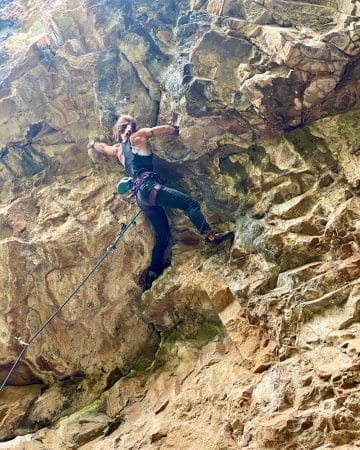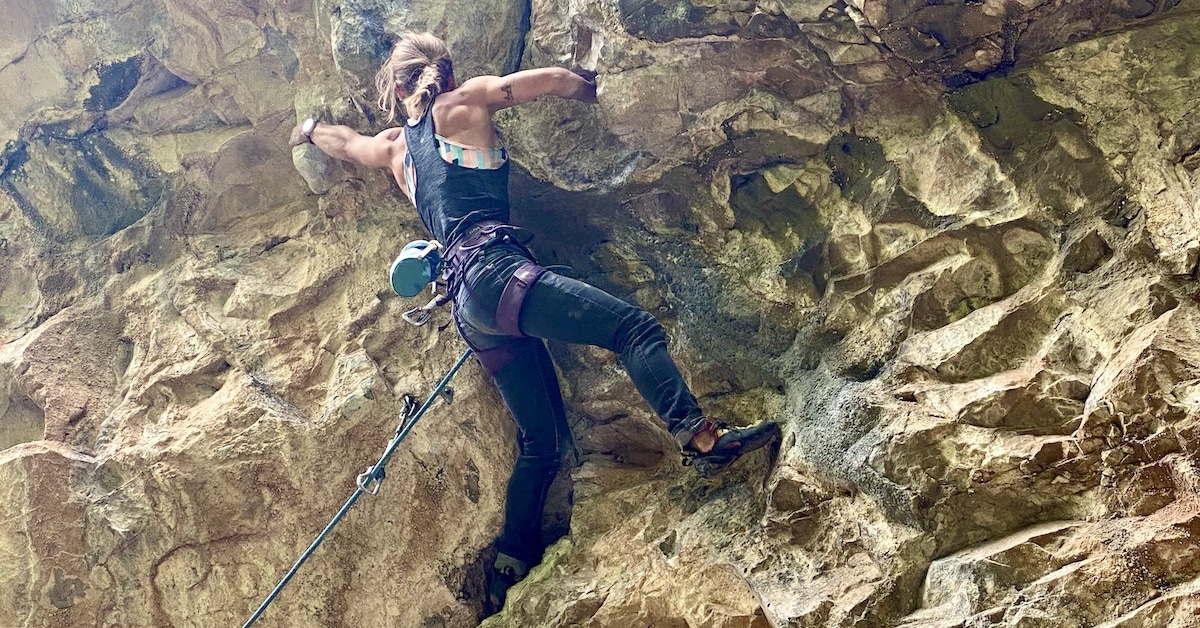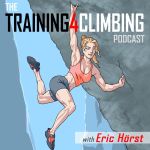Alright, shorties—no more excuses. Yes, we’ve got the “short” end of the stick sometimes. But with a little creativity and effort, it’s possible to make up the difference more often than not. Maximize your wingspan and your potential with these tips for short climbers.

We short climbers may be small, but we’re mighty. Make every inch of your wingspan count.
One of the most enticing things about climbing is the fact that it’s almost entirely customizable. Anyone of any body type or stature can enjoy this sport equally. There’s no one-size-fits-all approach to climbing; it all comes down to tactics.
…Ok, so there are definitely some deal-breakers out there. Sometimes the rock doesn’t offer a wide variety of options, and those on the far ends of the body size spectrum may have to cut their losses. But these roadblocks are, in the grand scheme of things, few and far between. Excuses far outnumber the actual number of times nature truly shuts climbers down.
As a 5’1” climber (with a -2 ape index to boot), I know a thing or two about excuses. I used to lean on them every time a hold felt out of reach, literally or figuratively, and still have a million reasons waiting on standby for why I just can’t do the move in any possible scenario. But as I’ve progressed in climbing, I’ve realized that excuses only hold me back from the creativity it takes to discover a solution. My height does not (always) have to be a limiting factor. An open mind and a good dose of stubbornness has taught me how to use my stature more wisely.
With that in mind, this one’s for all the fun-sized climbers out there. Use these tips to maximize your reach and squeeze your wingspan for all its worth. Soon enough, you’ll notice your own excuses giving way to creative solutions.
Gear
Outfit yourself for success. We’ll go from the ground up, beginning with the shoes on your feet. Normally, I prefer soft climbing shoes. I appreciate being able to feel the rock beneath my toes, taking advantage of every nook and cranny possible. This can be a helpful way for short climbers to find and utilize subtle footholds for a higher step, or to increase traction on tenuous stems. However, small climbers should also keep a pair of stiff shoes close at hand. A more rigid sole can prop you up higher on the rock, providing an extra few millimeters of reach—which, as we know, can make all the difference. When a hold lies just barely beyond your fingertips, start with switching out your shoes.
Rubber belongs on more than just your feet, though. Kneepads are a petite climber’s best friend. Sometimes all it takes to span a big distance is a sneaky kneebar to hold you into the wall and free up your arms. I say “sneaky” because you never know when the perfect opportunity will arise, especially for those of us with short shindexes. You may be able to fit into more slots and scums than your taller, or even average-sized, counterparts.
Finally, stock up on a set of long quickdraws. Don’t let clipping stances strip you of the send. Extend those babies as far as you need in order to use the intended stance. There’s no valor in wasting energy or risking safety on sketchy clips.
Technique
The closer you are to the wall, the farther short climbers can reach. Techniques that maximize proximity to the wall should come first in a short climber’s repertoire of skills.
Lower Body
Backsteps and drop-knees, which involve twisting the hips to align one side of the body with the wall, offer short climbers as much as a few extra inches of reach by eliminating the dead space between body and rock.
When two hands aren’t enough to get you there, make more out of your feet. Heel hooks operate like a third hand for additional leverage. With enough flexibility, a solid heel hook can help you get your feet as high as (or even higher than) your hands to facilitate an extreme lock-off. On that note, take any opportunity to perform a hand-foot match. Higher hands begin with higher feet.
For the holds that still remain out of static reach, you’ll need to get jumpy. Take a note from contemporary competition climbers here: dynos, pogos, and deadpoints, oh my! Dynamic movements such as these require a combination of physical power and mental trust. Practice them to perfection in controlled settings like the climbing gym to build confidence in your ability to go for it, then bring those skills to the less forgiving rock.

Sometimes the beta for short climbers is just to let it fly!
Upper Body
Get comfortable holding tension in your core. This is another way to maximize proximity to the rock for short climbers. A tight core holds your entire body in and prevents any sagging away from the wall. Engaged abdominals also allow for the limbs to extend out farther. Practice getting into spread-eagle positions on the wall with arms and legs stretched to full capacity. Hold these isometric positions, making note of how your core centers you in such a state and how close you can remain to the wall. From these extended positions, work on then building your feet up higher without losing grip in your hands.
If the hold you’re aiming for escapes wingspan, keep your eyes peeled for intermediates. Even the smallest sidepulls and most tenuous underclings can offer just enough of a boost to help you readjust your feet and go for gold from there. Bumping your way from one hold to another brings you steadily closer to your goal hold when making one long reach seems impossible.
Strength
To make the above techniques possible, short climbers will need to include certain elements in your regimen. Campus training on either traditional rungs or actual boulder problems is a given for the sake of recruiting power for dynamic moves. But contrary to popular belief, dynamic power comes from the lower body just as much as the upper. Plyometric exercises like jump squats, box jumps, and leaping lunges will teach your trunk how to generate power that ripples up through your entire body.
To develop the unilateral strength required for high steps, backsteps, drop-knees, and heel hooks, look no further than the notorious pistol squat. Keep your ego in check when introducing this exercise; go slow to avoid putting too much strain on your unsuspecting knees. Start with a chair behind you to limit the depth of your squat and catch any falls. Progress to full depth at bodyweight, and work towards bringing light dumbbells into the mix. When it comes to heel hooks specifically, rely on deadlifts (both traditional and unilateral) to fortify the backs of your legs and ward off hamstring injuries.
Finally, pay special attention to building strength toward the outer limits of your limbs. I’s, Y’s, and T’s using bands or TRX cables help brace the deltoids for especially spanny moves. Wide-grip pull-ups and push-ups also target these oft-neglected muscles on the side body that come into play during extended reaches. Put this kind of outer-limit strength into a climbing context with this isometric exercise:
- Hop on the spray wall and select two holds just barely within your wingspan. You should be able to grip them both with elbows only slightly bent.
- Pull onto the wall, taking weight off of your feet and working toward lifting yourself from the ground. Hold for five to ten seconds.
- Repeat with similar grips in a variety of directions: horizontal, vertical, and diagonal.
Performing well as a short climber requires both creativity and persistence. Believe that you can find a way, and you’re halfway there. Cover the rest of the distance with dedicated practice on the unique techniques and strength protocols necessary for making the most of each inch. Keep the faith, my fellow shorties. There’s hope for us yet.
Related Articles:
- Tall Beta: Hacks for Tall Climbers to Make the Most of Their Height
- Self-Discipline and Commitment: The Great Equalizers
- Belaytionship Tips for Safe, Confident Climbing with Your Belay Partner
- Training with Long Duration Isometric Exercises
- Steep Route Techniques to Climb Harder
Copyright © 2000–2023 Lucie Hanes & Eric J. Hörst | All Rights Reserved.











